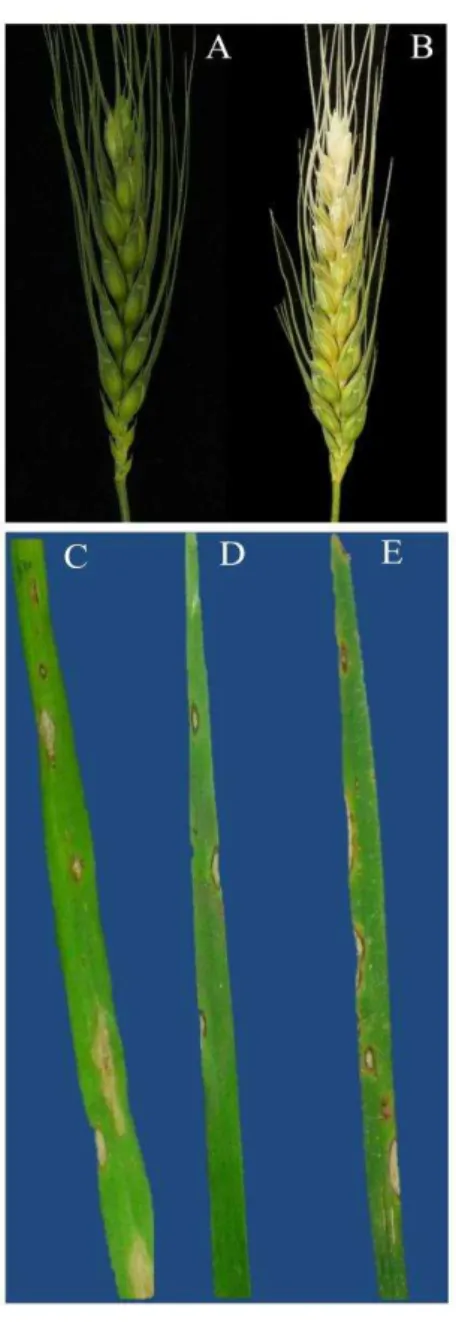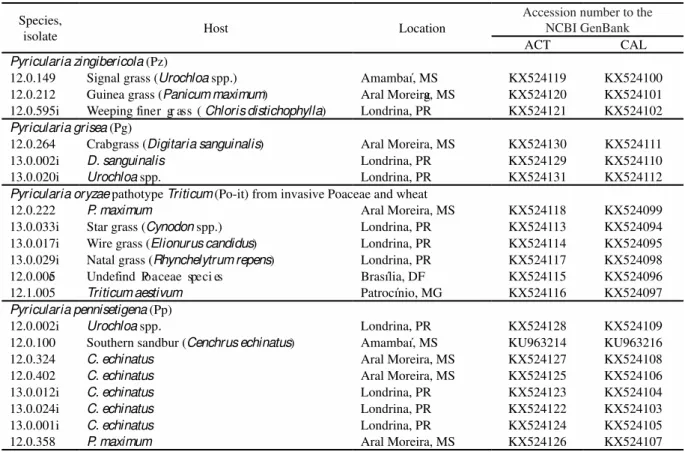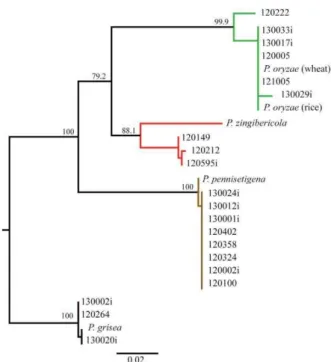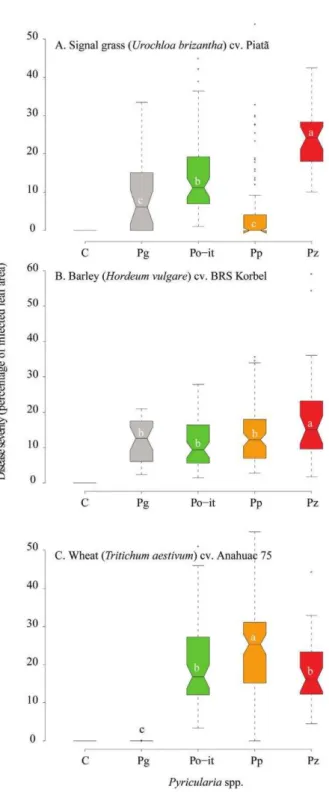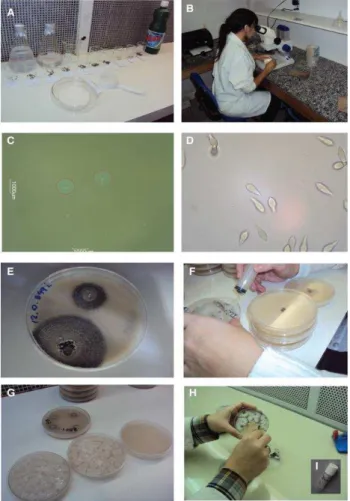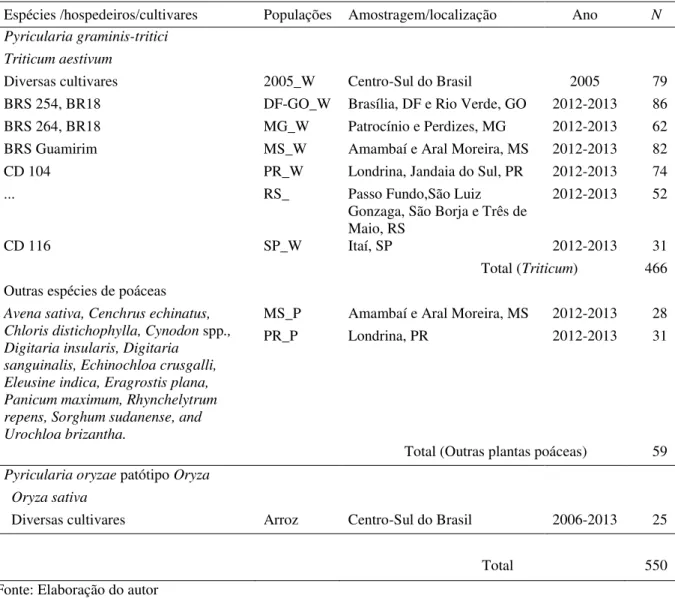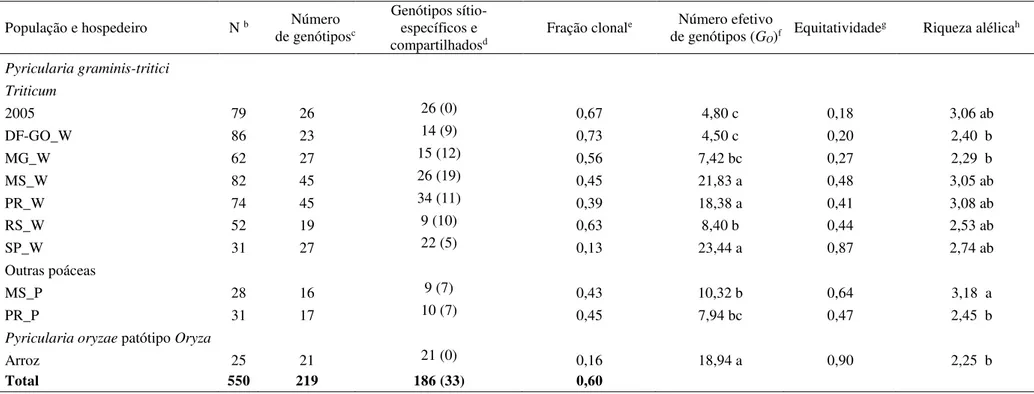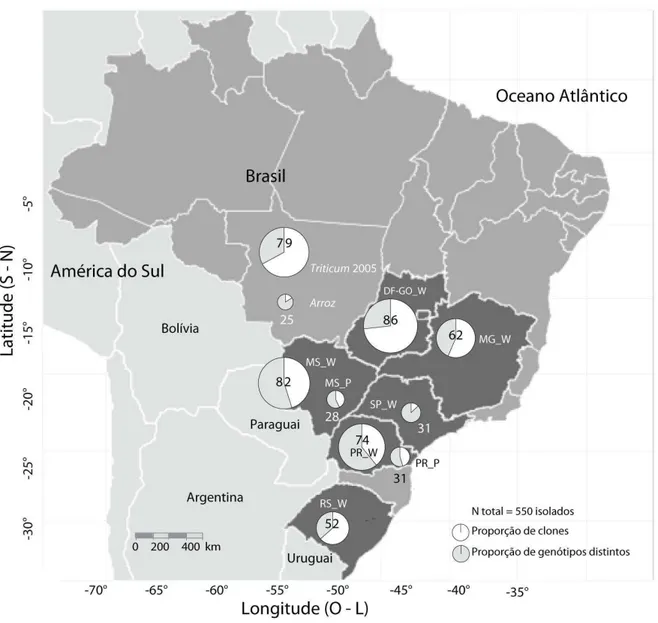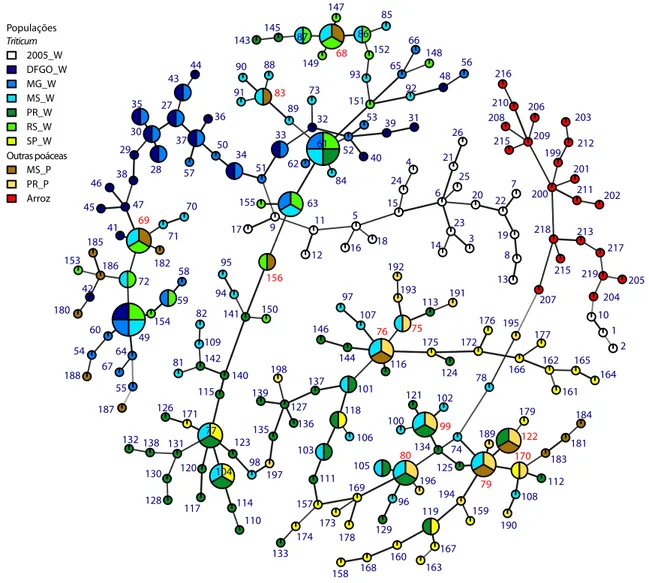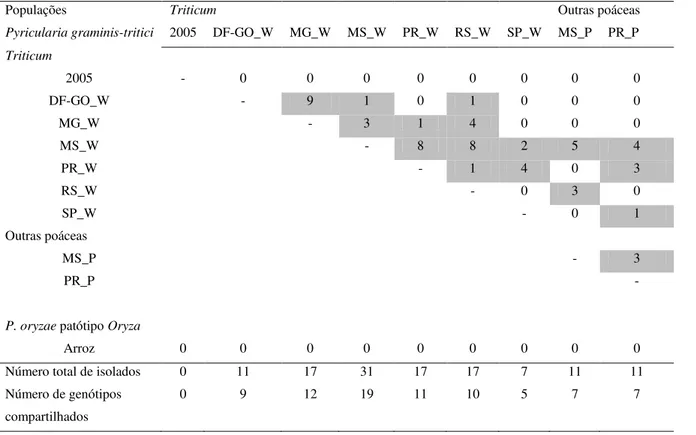FACULDADE DE ENGENHARIA
CAMPUS DE ILHA SOLTEIRA
JULIANA TEODORA DE ASSIS REGES
BIOLOGIA E ESTRUTURA GENÉTICA DE POPULAÇÕES DO
PATÓGENO DA BRUSONE DO TRIGO NO CENTRO-SUL DO BRASIL
PROGRAMA DE PÓS-GRADUAÇÃO EM AGRONOMIA
JULIANA TEODORA DE ASSIS REGES
BIOLOGIA E ESTRUTURA GENÉTICA DE POPULAÇÕES DO
PATÓGENO DA BRUSONE DO TRIGO NO CENTRO-SUL DO BRASIL
Tese apresentada à Faculdade de Engenharia de Ilha Solteira – UNESP como parte dos requisitos para obtenção do título de Doutor.
Especialidade: Sistema de Produção.
Prof. Dr. Paulo Cezar Ceresini
Orientador
Dr. João Leodato Nunes Maciel
Co-orientador
unesp"?t
UNIVERSIlADE EST ADUAl PAUllST A セ@...
-C!ltT1f1CADO DE BBセvaセ@
T1TuLO [),O, TEse, 1I4aIo9" "WL!Vo セゥ」iッ@ de poiャuセ@ "" PI(Jgoe"lO セ@ 1l1I._ dn tfIoo no c.".." .. セ@ do S ...
.I.l,/fOltl.: JUl..lAHA n::ODOllA DE ASSIS セgョ@ ORIENTAOOIt PAULO CfZAA CfRESIH I
CQ.ORIEWTADOR: .1010 L.ECOAlO セunヲs@ IoIAC IEl
Ap,o.adoII como P"IIe GIl, ">gtndu .or. ッ「ioNセNiッ@ <XI Titulo d, ilQulcf ' em AGRONOJ"jII\,
hセゥ。 ゥ ⦅[@ SISTE'-IAS DE PRoouCAo p.;" COI'II"SOO E •• .., I'IIIior. '
.yr..Jl,
[.,.JJ.tiJJ.
_"
i:ilo
PtG. 0.. o.w:tc:nO CARVAlHO UIHHOTO teiセQrッ|@ Fl U-OCIoi::*\iI"""''' " -__
e」アッセ@ FWoiOl . _ . I f _ <Ie tngomono do " " ' _L M BL セLLLLLL BMLLLLN セ MLL N Bᆳ
...
-,._-- ,,,",-,,-
" ,....
'-... ..,
...
-...
'
..
-A meu marido Reges, aos meus pais, Otaira e Wellington, pelo incentivo, compreensão, amor e por todos os ensinamentos de vida;
Às minhas irmãs, Fabiana e Tatiana, e a minha sogra Lauridia, avó Terezinha pelo carinho e companheirismo;
Aos meus sobrinhos, Gabriel, Kemilly, Ana Flávia e Eduardo, com carinho e amor;
A DEUS, sempre presente em minha vida, de quem tantas graças tenho recebido;
"Por isso não tema, pois estou com você; não tenha medo, pois sou o seu Deus. Eu o fortalecerei e o ajudarei; eu o segurarei com a minha mão direita vitoriosa."
Na primeira parte de nosso estudo descrevemos a associação de
Pyricularia pennisetigena e P. zingibericola a gramíneas invasoras de áreas de trigo no
centro-sul do Brasil. Desconhece-se, entretanto, qual o potencial de P. pennisetigena e P.
zingibericola como patógenos de poáceas de interesse econômico para a agricultura brasileira.
Dessa forma, objetivamos caracterizar o espectro de patogenicidade de P. pennisetigena e
P. zingibericola a braquiária, cevada e trigo e compará-lo com P. grisea e com a espécie até
recentemente descrita como P. oryzae patotipo Triticum, de ocorrência generalizada no
agroecossistema brasileiro. Foram testados 20 isolados de Pyricularia spp. obtidos de
amostras de folhas infectadas de plantas invasoras de campos de trigo. A classificação dos
isolados em espécies distintas de Pyricularia foi efetuada usando-se filogenia molecular
baseada nas sequencias parciais dos genes actina e calmodulina. Pyricularia pennisetigena e
P. zingibericola inoculadas em folhas, foram patogênicas a braquiária, cevada e trigo, com
diferenças na agressividade entre as espécies. Pyricularia zingibericola foi a espécie mais
agressiva a braquiária e cevada, enquanto P. pennisetigena foi a espécie mais agressiva em
plantas jovens de trigo. Por outro lado, P. grisea isolada de Digitaria sanguinalis ou de
Urochloa spp. não infectou trigo. A análise filogenética das regiões ACT e CAL concatenadas
reproduziu as relações filogenéticas e a magnitude das diferenças descritas entre Pyricularia
zingibericola, P. pennisetigena, P. oryzae patotipo Triticum e P. grisea. Urochloa spp.
provavelmente representam fonte permanente de inóculo inicial dos patógenos da brusone do
trigo entre as épocas de cultivo. Na segunda parte desta pesquisa, foi estudado a estrutura
genética de populações do patógeno da brusone do trigo, o fungo Ascomiceto Pyricularia
graminis-tritici sp. nov., no centro-sul do Brasil. Os objetivos foram responder às seguintes
perguntas: As populações geograficamente distintas de P. graminis-tritici do trigo eram
geneticamente subdivididas? Como se distribuía a diversidade gênica e genotípica entre as
populações regionais de P. graminis-tritici, cerca de 30 anos após as primeiras epidemias de
brusone no Brasil? Qual o sistema reprodutivo predominante de P. graminis-tritici no país?
Conclui-se que não houve subdivisão na maioria das populações geográficas contemporâneas
de P. graminis-tritici do trigo, indicando mecanismo eficiente de fluxo gênico. A magnitude e
a extensão do fluxo gênico entre populações geográficas de P. graminis-tritici do trigo, o
sistema reprodutivo predominantemente sexual, aliados a alta diversidade genética do fungo,
exemplo, o capim-braquiária (Urochloa brizantha), podem ter importante papel no ciclo de
vida e na biologia reprodutiva, na sobrevivência e na dispersão do inóculo de P.
graminis-tritici a curta e longa distâncias, mantendo as populações geográficas do patógeno conectadas.
Os padrões de fluxo gênico e genotípico entre populações hospedeiro-distintas do patógeno
reforçam a hipótese de que a brusone do trigo pode ter tido origem de novo a partir de
populações endêmicas de P. graminis-tritici que infectam outras espécies de poáceas (nativas
ou invasoras de áreas de trigo) no país.
Palavra-chave: Triticum aestivum,Pyricularia graminis-tritici, Patogenicidade,Hospedeiros,
ABSTRACT
In the first part of our study we described the association of Pyricularia pennisetigena
and P. zingibericola with invasive grasses from wheat cropping areas in South-Central Brazil.
However, the potential of P. pennisetigena and P. zingibericola as pathogens to poaceous
plants of economic interest for Brazilian agriculture is still unknown. Therefore, this study
aimed to characterize the pathogenicity spectrum of P. pennisetigena and P. zingibericola to
signal grass, barley and wheat and compare with P. grisea and with the species until recently
described as P. oryzae pathotype Triticum, of widespread occurrence in the Brazilian
agro-ecosystem. Twenty isolates of Pyricularia spp. obtained from samples of infected leaves of
weed species in wheat fields were tested. Classification of isolates into different species of
Pyricularia was performed using molecular phylogeny based on the partial actin and
calmodulin gene sequences. Pyricularia pennisetigena and P. zingibericola inoculated on
leaves were pathogenic to signal grass, barley and wheat, with differences in aggressiveness
between species. Pyricularia zingibericola was the most aggressive species to signal grass
and barley, while P. pennisetigena was the most aggressive species to young plants of wheat.
On the other hand, P. grisea isolated from Digitaria sanguinalis or Urochloa spp. did not
infect wheat. Phylogenetic analysis of the concatenated regions ACT and CAL reproduced the
phylogenetic relationships and the magnitude of the differences reported between Pyricularia
zingibericola, P. pennisetigena, P. oryzae pathotype Triticum and P. grisea. Urochloa spp.
probably represents a permanent source of initial inoculum of the wheat blast pathogens
between growing seasons. In the second part of this research, we studied the genetic structure
of populations of the wheat blast pathogen, the Ascomycete fungus Pyricularia graminis
-tritici sp. nov., in the South-Central Brazil. The objectives were to answer the following
questions: The geographically distinct populations of P. graminis-triticiwheat were
genetically subdivided? How gene and genotypic diversity were distributed among regional
populations of P. graminis-tritici about 30 years after the first outbreaks of wheat blast in
Brazil? What is the predominant reproductive system of P. graminis-tritici in the country? We
concluded that there was no subdivision among most of the contemporary geographical
populations of Pyricularia graminis- tritici from wheat fields, indicating an efficient
mechanism of gene flow. The magnitude and extent of gene flow among geographical
potential in the Brazilian agro-ecosystem. Other species of poaceous hosts with wide
geographic distribution in Brazil, for example, signal grass (Urochloa brizantha) can play an
important role in the life cycle and reproductive biology, survival and spread of inoculum of
P. graminis- tritici at short and long distances, keeping the geographical populations of the
pathogen connected. The patterns of gene and genotypic flow between host-distinct
populations of the pathogen reinforce the hypothesis that the wheat blast may had a de novo
origin from endemic populations of P. graminis-tritici infecting other poaceous species
Figura 1 Espiga assintomática não inoculada (A), brusone em espiga de trigo (B) e lesões foliares em trigo cv. Anahuac (C), cevada cv. BRS Korbel (D) e braquiária cv. Piatã (E) inoculadas com Pyricularia graminis-tritici...22
Capítulo 1
Figura 1 Reconstruction of the phylogenetic relationship among four species of the Pyricularia genus, based on sequences of the actin (ACT) and calmodulin (CAL) genes concatenated. Maximum likelihood (ML) implemented in the PhyML algorithm was used. The internode support for the branches was tested by 10,000 bootstrap resamplings of the data...34
Figura 2 Boxplots representing the pathogenicity of Pyricularia species to signal grass (A), barley (B) and wheat (C).Pg = Pyricularia grisea (n = 3); Po-it = Pyricularia oryzae pathotype Triticum (n = 6); Pp = Pyricularia pennisetigena (n = 8); Pz = Pyricularia zingibericola (n = 3); C
(control), with n = number of isolates per
species)... 36
Figura 3 Photographs of leaf blast symptoms caused by different species of
Pyricularia on the leaves of signal grass cv. Piatã (A), barley cv. BRS Korbel (B) and wheat cv. Anahuac 75 (C). Pg = P. grisea; Po-it = P. oryzae pathotype Triticum; Pp = P. pennisetigena; Pz = P. zingibericola; C=control ... 36
Capítulo 2
Figura 1
...
Processo de isolamento e preservação de culturas monospóricas puras do patógeno da brusone do trigo e de plantas invasoras (Pyricularia graminis-tritici) no Centro-Sul do Brasil 47
Figura 2
Figura 3
Estratégia de amostragem populacional de isolados de Pyricularia graminis-tritici associados à brusone em espigas de trigo e em folhas de de plantas poáceas invasoras no centro-sul do Brasil, nas safras de 2012 e 2013.. ... 54
Rede mínima de expansão baseada em distância de Bruvo para comparação entre genótipos microssatélites de 219 genótipos de
Pyricularia graminis-tritici do trigo e de outras poáceas e de P. oryzae
Capítulo 1
Tabela 1 Isolates and their respective Pyricularia species obtained from grass plants invasive to wheat fields in 2012 and 2013, as well as their accession number for the actin (ACT) and calmodulin (CAL) gene sequences deposited at the NCBI GenBank...32
Tabela 2 Variance analysis table for testing the effects of the experiment, species and pathogen isolates on the aggressiveness of Pyricularia spp. to signal grass, barley and wheat. . 35
Capítulo 2
Tabela 1 Descrição de populações de Pyricularia graminis-tritici do trigo e de outras plantas poáceas e de Pyricularia oryzae patótipo Oryza do arroz
amostradas no Centro-Sul do Brasil… 444444…47…47.. 48
Tabela 2 Medidas de diversidade genotípica e gênica em populações simpátricas de Pyricularia graminis-tritici e P. oryzae patótipo Oryza no Centro-Sul do Brasil……….. 53
Tabela 3
Tabela 4
Número de genótipos multiloci microssatélites compartilhados entre populações de Pyricularia graminis-tritici do trigo, de outras espécies poáceas e P. oryzae patótipo Oryza no Centro-Sul do Brasil……….. 58
Compartilhamento de 11 genótipos multiloci entre populações de
Pyricularia graminis-tritici amostradas de trigo e de outras poáceas invasoras de áreas de trigo no Centro-Sul do Brasil……….. 59
Tabela 5 Distribuição hierárquica da diversidade gênica entre populações de gene de Pyricularia graminis-tritici do trigo, de outras poáceas e de
Pyricularia oryzae de arroz no Centro-Sul do Brasil...61
Tabela 6 Medidas de diferenciação entre populações de Pyricularia spp. do trigo, de outras poáceas e de arroz no Centro-Sul do Brasil, baseadas em
graminis-tritici do trigo, e de outras poáceas e P. oryzae patótipo Oryza
de arroz no Centro-Sul do
Brasil... 66
1. INTRODUÇÃO GERAL 15
2. REFERÊNCIAS 24
Capítulo 1:Pyricularia pennisetigena e P. zingibericola de gramíneas invasoras infectam
braquiária, cevada e trigo 30
RESUMO 30
ABSTRACT 30
1. INTRODUCTION 30
2. MATERIAL AND METHODS 31
3. RESULTS AND DISCUSSION 33
4. CONCLUSIONS 37
5. ACKNOWLEDGMENTS 37
6. REFERENCES 37
Capítulo 2: Estrutura genética de populações contemporâneas do patógeno da brusone
do trigo (Pyricularia graminis-tritici sp.nov) no centro-sul do Brasil 39
RESUMO 39
ABSTRACT 40
1. INTRODUÇÃO 41
2. MATERIAL E MÉTODOS 45
2.1 Amostragem de populações geográficas de Pyricularia graminis-tritici (PoT) adaptadas
ao trigo e a outras poáceas em lavouras do Centro-Sul do Brasil 45
2.2 Isolamento de Pyricularia graminis-tritici 45
2.3 Genotipagem de populações de isolados de Pyricularia graminis-tritici usando sequencias de DNA nuclear, alelos de idiomorfos de tipos de compatibilidade (mating types) e
marcado-res microssatélites 48
2.4 Análise da estrutura genética de populações de Pyricularia graminis-tritici 49
2.4.1 Diversidade genotípica e riqueza alélica 50
2.4.2 Rede mínima de expansão entre genótipos (RME) 50
2.4.3 Magnitude do fluxo gênico 51
2.4.4 Testes de equilíbrio gamético 51
3. RESULTADOS E DISCUSSÃO 52
3.1 Diversidade genotípica e gênica. 52
3.4 Predominância de equilíbrio gamético nas populações do patógeno 63
4. CONCLUSÕES 68
1 INTRODUÇÃO GERAL
Os primeiros relatos sobre ocorrência de doença brusone datam de 1637 na cultura do arroz na China (OU,1985). Por sua vez, no último século, emergiu como patógeno importante adaptado a cultura do trigo no sul do Brasil (IGARASHI et al., 1986) e espalhou-se para outros países que cultivam trigo na América do Sul, como Bolívia e Paraguai (DUVEILLER et al., 2010) e mais recentemente para Bangladesh, na Ásia (CALLAWAY, 2016). A brusone é uma doença extremamente importante que causa perdas elevadas à produção de culturas agrícolas de importância mundial (OU, 1985; GOULART; PAIVA, 2000; PRABHU et al., 2003). O patógeno da brusone do trigo está catalogado como um sério patógeno quarentenário que ameaça à agricultura americana (MADDEN; WHEELIS, 2003; STRANGE; SCOTT, 2005; KOHLI et al., 2010).
Os primeiros surtos da brusone do trigo no Brasil, com prejuízos significativos à produção, ocorrem no ano de 1986, nas regiões Norte e Oeste do Paraná (PR), assim como Noroeste de São Paulo e Sul do Mato Grosso do Sul. No ano de 1987, a doença atingiu proporções epidêmicas, e muitas lavouras apresentaram desde perdas parciais até perdas totais de produtividade. Naquele ano, setenta municípios somaram prejuízos entre 10 a 12% da produção (IGARASHI et al., 1986; IGARASHI, 1988). Em 1988, devido a fatores como a utilização de sementes infetadas pelo patógeno, a presença de inóculo da safra anterior no restos de cultura, a elevada suscetibilidade dos cultivares de trigo utilizados e as condições ambientais favoráveis ao desenvolvimento da doença, a brusone foi detectada já aos dez dias após o florescimento. Nesse ano detectou-se elevada ocorrência de brusone em campos de trigo nos Vales do Paranapanema, Ivaí e Tibagi, PR, especialmente em cultivares precoces, semeadas até a primeira quinzena de abril (IGARASHI, 1988).
Entre 1988 e 1992 foram avaliadas as perdas causados pela brusone do trigo no Mato Grosso do Sul, tendo sido constatado que o prejuízo econômico da doença decorria da redução na produção, na qualidade e no rendimento de grãos. Os altos prejuízos econômicos causados pela brusone voltaram a ocorrer na safra de 2004, com maior intensidade de ocorrência no Cerrado brasileiro, especialmente no Mato Grosso do Sul, e nas regiões Norte e Oeste do Paraná, resultando em alerta geral sobre a severidade da doença aos produtores de trigo e cevada destas regiões(PRABHU; FILIPPI, 2006).
PERELLÓ et al., 2011). A brusone do trigo foi relatada, também, no Paraguai, Uruguai e Bolívia (URASHIMA, 2010).
Provavelmente devido a eventos climáticos extremamente favoráveis nas regiões produtoras, na safra de 2009/2010, epidemias de brusone do trigo ocorreram de forma generalizada no Brasil, tendo sido detectada desde o norte do Paraná até o Distrito Federal (TORRES, 2009), despertando a atenção dos serviços de extensão rural locais, bem como da comunidade científica nacional e internacional (DUVEILLER et al., 2010).
Em meados de fevereiro de 2016 ocorreu o primeiro relato de uma epidemia de brusone do trigo fora da América do Sul. A doença foi detectada em Bangladesh, no sudeste da Ásia, ocasionando perdas elevadas nas lavouras de trigo do país. Análises patogenômicas de amostras coletadas nos campos de trigo indicaram que o patógeno introduzido em Bangladesh possivelmente teve origem de populações do patógeno que infectam o trigo no Brasil (CALLAWAY, 2016; CROLL, 2016).
Novas alterações taxonômicas recentemente propostas, baseadas na combinação de dados biológicos e morfológicos pré-existentes com dados filogenéticos, foram usadas para reexaminar as relações entre espécies tipo Pyricularia, que pertencem à ordem Magnaporthales. A ordem Magnaporthales originalmente com uma única família, a Magnaporthaceae, era composta por 13 gêneros e mais de 100 espécies (ILLANA et al., 2013). As mudanças na ordem Magnaporthales foram relevantes e resultaram na definição de três famílias novas: Magnaporthaceae (baseada em Nakataea spp.), Pyriculariaceae (baseada em Pyricularia spp.) e Ophioceraceae (baseada em Ophioceras spp.) (KLAUBAUF et al., 2014), sendo excluído o gênero Magnaporthe da familia Magnaporthaceae (LUO; ZHANG, 2013). O reposicionamento da maioria das espécies alocadas no gênero “Magnaporthe” foram recepcionadas no gênero complexo polifilético Pyricularia, família Pyriculariaceae (LUO; ZHANG, 2013; KLAUBAUF et al., 2014). Procedeu-se à redefinição de novas combinações e novos taxas em todos os gêneros e propôs-se a mudança definitiva de nome para os fungos Magnaporthe grisea
e Magnaporthe oryzae, respectivamente, para Pyricularia grisea (associado a Digitaria spp.) e
as espécies desse gênero, Pyricularia oryzae é possivelmente o patógeno mais importante em função de sua distribuição cosmopolita em plantas poáceas. A brusone ocasionada por P. oryzae
é responsável por perdas severas, sob condições predisponentes, em culturas de importância econômica como arroz (Oryza sativa), aveia (Avena sativa), capim-braquiária (Urochloa spp.), centeio (Secale cereale), cevada (Hordeum vulgare), milho (Zea mays) e trigo (Triticum aestivum) ( ANJOS et al., 1996; BAILEY; EIJNATTEN, 1961; COUCH et al., 2005; COUCH; KOHN 2002; IGARASHI et al., 1986; GOULART et al., 2003; MARCHI et al., 2005; URASHIMA et al., 1993).
A adoção da designação de P. oryzae como espécie associada à brusone é recente em todo o mundo. Até o final dos anos 2000, considerava-se Pyricularia grisea como patógeno da brusone em arroz, braquiária, cevada e trigo (AVERNA-SACCA, 1912; IGARASHI et al., 1986; URASHIMA et al., 1993; GOULART et al., 2003; MARCHI et al., 2005). Após reclassificação filogenética molecular proposta em 2002 (COUCH; KOHN, 2002), P. grisea
foi associada somente à brusone em gramíneas do gênero Digitaria e P. oryzae passou a ser associada ao arroz, trigo e outras gramíneas cultivadas ou invasoras, como capim-pé-de-galinha, razão pela qual adotou-se a nova classificação internacional.
O fungo P. oryzae, é considerado uma espécie complexa composta por subgrupos diferentes, agrupados por tipos de acasalamento (mating types), por características filogenéticas peculiares e pela gama restrita de hospedeiros ou patótipos (TOSA; CHUMA, 2014). Os patótipos representativos de P. oryzae e seus respectivos hospedeiros até então descritos são patótipo Oryza, patogênico ao arroz (Oryzae sativa); patótipo Panicum, patogênico a milheto comum(Panicum miliaceum); patótipo Setaria, patogênico a painço (Setaria italica); patótipo
Triticum, patogênico ao trigo (Triticum aestivum); patótipo Avena, patogênico à aveia (Avena sativa); patótipo Eleusine, patogênico a capim-pé-de-galinha (Eleusine coracana) e patótipo
Lolium, patogênico a azevém perene (Loliumperenne) (TOSA; CHUMA, 2014). Considerando as diferenças filogenéticas entre os grupos, a designação de patótipo, poderia, perfeitamente dar lugar à definição de novas espécies de Pyricularia pertencentes ao complexo P. oryzae
(KLAUBAUF et al., 2014; CASTROAGUDIN et al., 2016).
CH7-BAC9, CHS1, EF-1α, MPG1 e NUT1, onde foram incluídos 105 isolados originalmente denominados P. oryzae patótipo Triticum, amostrados de populações simpátricas de trigo e de plantas invasoras e 23 isolados de P. oryzae patótipo Oryza, os isolados foram agrupados em três clados filogenéticos:clado 1, composto por isolados obtidos apenas de arroz (P. oryzae
patótipo Oryza), clado 2, composto por isolados da espécie P. oryzae patótipo Triticum e clado 3, com isolados de plantas trigo e plantas invasoras. Identificou-se que o clado 3 é distinto de
P. oryzae e representa uma nova espécie, a qual foi denominada Pyricularia graminis-tritici sp. nov. Com isso, sugeriu-se que a brusone em trigo e outras Poaceae, no Brasil, é causada por pelo menos duas espécie de Pyricularia, P. graminis-tritici e P. oryzae patótipo Triticum. Evidência adicional baseada em genômica populacional comparativa que incluiu a análise de sequências de genomas inteiros dos mesmos isolados do patógeno da brusone do trigo analisados por Castroagudin et al. (2016) sugere-se, entretanto, que P. graminis-tritici sp. nov. e P. oryzae patótipo Triticum devem representar uma única espécie, altamente diversa, P. graminis-tritici.
Com as descobertas recentes, reconhecer e nomear de forma apropriada o agente causal da brusone do trigo como P. graminis-tritici, não somente melhorará nossa compreensão da biologia e epidemiologia da doença, mas também capacitará o estabelecimento de medidas regulatórias quarentenárias adequadas, visando limitar a disseminação deste patógeno para áreas livres da doença onde cultivares suscetíveis de trigo são cultivadas, incluindo Ásia, Europa e América do Norte (MCTAGGARTet al., 2016).
A biologia reprodutiva de fungos Ascomicetos, do gênero Pyricularia, tem sido exaustivamente estudada usando como modelo a espécie Pyricularia oryzae do arroz (TALBOT, 2003). Considerando que P. oryzae é considerado auto-incompatível, sua fase sexuada só se forma quando ocorre o cruzamento entre dois indivíduos de tipos sexualmente compatíveis e que sejam férteis. Isso ocorre quando a estrutura receptora, feminina, chamada ascogônio está apta a receber o(s) núcleo(s) do indivíduo compatível, doador, masculino, por meio de conídios ou hifas receptoras (KANG et al., 1994; MOREIRA et al., 2015; ). O reconhecimento dos indivíduos sexualmente compatíveis é regulado por genes mating type, também denominados de tipos sexualmente compatíveis ou de acasalamento (TURGEON,1998; MOREIRA et al., 2015). O gene que controla o tipo compatível em
P. oryzae tem dois idiomorfos, denominados MAT1-1 e MAT1-2 (NOTTÉGHEM; SILUÉ, 1992; PEIXOTO, 2014).
sexuada do patógeno raramente é encontrada no campo (SALEH et al., 2012). A detecção da distribuição equitativa dos dois tipos compatíveis, e observação de equilíbrio gamético em populações do patógeno, representam uma forma indireta de relacionar se o modo reprodutivo do patógeno, no campo, é essencialmente sexual ou predominantemente clonal (MACIEL et al., 2014). Durante o processo de reprodução sexuada, progênies de ambos “mating types”são produzidasem proporções semelhantes (NOTTÉGHEM; SILUÉ, 1992; PEIXOTO, 2014). Se a distribuição detectada for equitativa de ambos “mating types”, supõe-se que há chances da reprodução sexuada ocorrer em populações de campo.
Diversas pesquisas que avaliaram a distribuição de “mating types” de P. oryzae
confirmaram que a distribuição de frequência dos “mating types” é não equitativa na maioria das populações estudadas em diferentes países. Em alguns países foi observado predomínio de
MAT1-1, como na Argentina (CONSOLO et al., 2005), no Brasil (MACIEL et al., 2014) e na Colômbia (KATO; YAMAGUCHI, 1982); em parte da União Européia (KATO; YAMAGUCHI, 1982; NOTTÉGHEM; SILUÉ, 1992); na Costa do Marfim, no Egito, nas Filipinas, na Índia e no Japão (KATO; YAMAGUCHI, 1982; DAYAKAR et al., 2000). Enquanto isso, MAT1-2 predominouna China, na Indonésia, na Malásia, e na Guiné (KATO; YAMAGUCHI, 1982; YAEGASHI; YAMADA, 1986).
A dispersão do patógeno acompanhando a expansão mundial do cultivo do arroz pode ter levado a fixação de um único “mating type” em áreas novas de rizicultura na África, América, Europa e até mesmo na Ásia, impondo um modo assexuado obrigatório de reprodução em populações do patógeno fora do centro de origem asiático (SALEH et al., 2012; PEIXOTO 2014).
Muito pouco se conhece sobre a ecologia de populações de P. graminis-tritici. Sabe-se que o patógeno da brusone do trigo pode ser eficientemente disperso a curta e a longa distância por inóculo aéreo, i.e. conídios (URASHIMA et al., 2007) e também por sementes infectadas (GOULARt et al., 1995).
Em condições de laboratório, as amostras de P. graminis-tritici do trigo tem alta capacidade de cruzamento sexual formando quantidades abundantes de peritécios, ascas e ascosporos (URASHIMA et al., 2005). No entanto, o papel dos ascósporos nas epidemias de brusone do trigo é desconhecido, bem como a importância relativa dos ascósporos, em comparação com esporos assexuais (conídios), para os ciclos de infecção primária (URASHIMA et al., 2005).
(URASHIMA et al., 1993). Linhagens de P. graminis-tritici provenientes de trigo foram capazes de infectar plantas Poáceas de seis tribos distintas (URASHIMA et al., 1993; REGES et al., 2016). Notavelmente, as linhagens de P. graminis-tritici provenientes de plantas de trigo foram capazes de infectar gramíneas das tribos Hordeae, Festuceae, Avenae, Chlorideae, Agrosteae e Paniceae. Peritécios maduros com meiósporos viáveis, evidência de cruzamentos férteis, foram produzidos quando as linhagens procedentes de trigo foram cruzadas com as linhagens de Eleusine coracana (Chlorideae), Urochloa plantaginea (Paniceae), e Setaria indica (Paniceae) (URASHIMA et al., 1993). Cruzamentos entre linhagens de P. graminis-tritici derivadas de plantas de trigo com linhagens de P. oryzae patótipo Oryza derivadas do arroz foram estéreis (URASHIMA et al., 1993). Além disso, em "Southern blots" usando sondas tipo retrotransposões MGR (URASHIMA et al., 1999), isolados do P. graminis-tritici do trigo apresentaram impressões digitais de DNA (fingerprinting) típicas de não patógenos do arroz, com ausência dos elementos MGR-586 (VALENT; CHUMLEY, 1991) e MGR-583 (URASHIMA et al., 1999; FARMAN, 2002). As linhagens de P. oryzae patótipo Oryza, normalmente têm número elevado de cópias do MGR-586. É mais provável que estes isolados que infectam trigo sejam derivados de patógenos de outras plantas poáceas que de arroz (HAMER, 1991).
Paradoxalmente em relação à P. graminis-tritici, P. oryzae do arroz, parece ter uma gama de hospedeiros mais restrita. Apesar da situação endêmica da brusone do arroz no Brasil desde 1912 (AVERNA-SACCA,1912), P. oryzae do arroz só infectou cultivar de trigo suscetível sob condição altamente predisponentes, em casa de vegetação (CASTROAGUDIN et al., 2016). Por outro lado P. graminis-tritici proveniente do trigo não infecta arroz (URASHIMA et al., 1993; CASTROAGUDIN et al., 2016).
Pyricularia oryzae patótipo Oryza é considerado patógeno de alto potencial evolutivo (PRABHU et al., 1992; MEHTA; BAIER, 1998, URASHIMA et al., 2005). O patógeno
O potencial evolutivo de uma população de um patógeno qualquer é um reflexo de sua estrutura genética populacional (MCDONALD; LINDE 2002a). Populações de patógenos com alto potencial evolutivo têm maior probabilidade de vencer a resistência genética do hospedeiro. McDonald e Linde (2002a) propuseram um modelo flexível para se determinar o potencial evolutivo das populações de patógenos com base na análise de sua estrutura genética (MCDONALD; LINDE, 2002a; MCDONALD; LINDE, 2002b). De acordo com esse modelo, os patógenos que apresentam maior risco de quebra de genes de resistência das plantas têm um sistema reprodutivo misto, um elevado potencial para o fluxo gênico, grande tamanho efetivo populacional e alta taxa de mutação. Os patógenos de mais baixo risco são aqueles com reprodução assexuada estrita, baixo potencial de fluxo gênico, pequeno tamanho efetivo de população e baixas taxas de mutação. É plausível que P. graminis-tritici do trigo tenha potencial evolutivo semelhante ao descrito para P. oryzae patótipo Oryza (CERESINI, 2011).
A brusone do trigo foi descrita como doença predominantemente de espigas. Em espigas sadias, frequentemente nenhuma descoloração é observada (Figura 1A). Em espigas infectadas, os sintomas envolvem branqueamento parcial ou total (Figura 1B), em função do ponto de necrose inicial provocada pelo fungo na ráquis (IGARASHI, 1988). A predominância de sintomas em espigas e a rara incidência da brusone nas folhas do trigo leva à hipótese de que o inóculo primário do patógeno provém de lesões em outros hospedeiros (DUVEILLER et al., 2010), especialmente em espécies de poáceas cultivadas em larga escala como pastagens dos gêneros Urochloa (braquiária) e Panicum (REGES et al., 2016).
Figura 1 - Espiga assintomática não inoculada (A), brusone em espiga de trigo (B) e lesões foliares em trigo cv. Anahuac (C), cevada cv. BRS Korbel (D) e braquiária cv. Piatã (E) inoculadas com Pyricularia graminis-tritici.
Fonte : Elaboração do autor.
REFERÊNCIAS
ANJOS, J. R. N. D. et al. Ocorrência de brusone (Pyricularia grisea) em trigo e centeio na região dos cerrados do Brasil Central. Pesquisa Agropecuária Brasileira, Rio de Janeiro, v. 31, n. 1, p. 79-82, 1996.
AVERNA-SACCA, R. "Brusone" do arroz. Boletim de Agricultura, São Paulo, v. 13a, n. 4, p. 291-302, 1912.
BAILEY, A. G.; EIJNATTEN, C. V. Corn gray spot caused by Pyricularia grisea.
Phytopathology, St. Paul, v. 51, n. 2, p. 197- 198, 1961.
CABRERA, M. G.; GUTIÉRREZ, S.A. Primer registro de Pyricularia grisea en cultivos de trigo del noreste de Argentina. Jornada de actualización en enfermedades de trigo. Lavallol: Buenos Aires, 2007. v. 60.
CALLAWAY E. Devastating wheat fungus appears in Asia for first time. Nature, New York, v. 532, n.2, p. 421–422, 2016.
CASTROAGUDÍN, V. L.; MOREIRA, S. I.; PEREIRA, D. A. S.; MOREIRA, S. S.; BRUNNER,P.C., MACIEL J.L.N, CROUS.P.W, MCDONALD.B.A, ALVES E., CERESINI. P. C. Pyricularia graminis-tritici, a new Pyricularia species causing wheat blast. Persoonia,
Leiden, v.37, p. 199–216, 2016.
CERESINI, P. C. Estrutura genética de populações do patógeno da brusone do trigo
Magnaporthe oryzae no Brasil. 2011. 116 f. Tese (Livre docência) – Faculdade de Engenharia,
Universidade Estadual Paulista - UNESP, Ilha Solteira.
CONSOLO, V. F.; CORDO, C. A.; SALERNO, G. L. Mating-type distribution and fertility status in Magnaporthe grisea populations from Argentina. Mycopathologia, Dordrecht, v. 160, n.4, p. 285-290, 2005.
CORREA-VICTORIA, F. J.; ZEIGLER, R. S. Pathogenic variability in Pyricularia grisea at a rice blast 'hot spot' site. Plant disease, St. Paul, v. 77, n.10, p. 1029-1034, 1993.
COUCH, B. C. et al. Origins of host-specific populations of the blast pathogen Magnaporthe oryzae in crop domestication with subsequent expansion of pandemic clones on rice and weeds of rice. Genetics, Bethesda, v. 170, n. 2, p. 613-630, 2005.
COUCH, B. C.; KOHN, L. M. A multilocus gene genealogy concordant with host preference indicates segregation of a new species, Magnaporthe oryzae, from M. grisea. Mycologia,
Lawrence, v. 94, n. 4, p. 683-693, 2002.
CROLL, D. The origin of wheat blast in Bangladesh. [S. l.: s. n], 2016. Disponível em: <https://github.com/crolllab/wheat-blast>. Acesso em: 27 jul. 2016.
DAYAKAR, B. V.; NARAYANAN, N. N.; GNANAMANICKAM, S. S. Cross-compatibility and distribution of mating type alleles of the rice blast fungus Magnaporthe grisea in India.
DUVEILLER, E.; HODSON, D.; TIEDMANN, A. Wheat blast caused by Magnaporthe grisea: a reality and new challenge for wheat research. In: INTERNATIONAL WHEAT CONFERENCE, 8., 2010, Saint Petersburg. Abstracts. Saint Petersburg; St. Petersburg: Vavilov Research Institute of Plant Industry, 2010. p. 247-248.
FARMAN, M. L. Pyricularia grisea isolates causing gray leaf spot on perennial ryegrass (Lolium perenne) in the United States: Relationship to P. grisea isolates from other host plants.
Phytopathology, St. Paul, v. 92, n. 3, p. 245-254, 2002.
FILIPPI, M. C.; PRABHU, A. S. Phenotypic virulence analysis of Pyricularia grisea isolates from Brazilian upland rice cultivars. Pesquisa Agropecuária Brasileira, Brasília, DF, v. 36, n.1, p. 27-35, 2001.
GOULART, A. C. P.; PAIVA, F. A.; ANDRADE, P. J. M. Relação entre a incidência da brusone em espigas de trigo e a presença de Pyricularia grisea nas sementes colhidas.
Fitopatologia brasileira, Brasilia, DF, v. 20, n.2, p. 184-189, 1995.
GOULART, A.C.P. & PAIVA, F. A. Perdas no rendimento de grãos de trigo causadas por
Pyricularia grisea, nos anos de 1991 e 1992, no Mato Grosso do Sul. Summa Phytopathologica, Botucatu, v. 26, n.2, p. 279-282, 2000.
GOULART, A. C. P.; AMABILI, R. F.; NASSER, L. C. B.; FREITAS, M. A. Detecção de
Pyricularia grisea em sementes de cevada produzidas em sistema irrigado por pivô central no Cerrado Brasileiro. Fitopatologia Brasileira, Brasília, DF,v. 28, n.5, p. 565-565, 2003.
HAMER, J. E. Molecular probes for rice blast disease. Science, Washington, v. 252, n.5006, p. 632-633, 1991.
IGARASHI, S. et al. Pyricularia em trigo. 1. Ocorrência de Pyricularia sp. no estado do Paraná.
Fitopatologia Brasileira, Brasília, DF, v. 11, n.3, p. 351-352, 1986.
IGARASHI, S. Análise da ocorrência de brusone do trigo no Paraná. In: RENAPET –
REUNIÃO NACIONAL DE PESQUISA DE TRIGO, 15., Passo Fundo. Anais... Passo Fundo: CNPT/EMBRAPA, 1988. p.1-19.
ILLANA, A.; RODRIGUEZ-ROMERO, J.; SESMA, A. Major plant pathogens of the
Magnaporthaceae family. In: HORWITZ, B. A.; MUKHERJEE, P. K.; MUKHERJEE, M.; KUBICEK, C. P. (Ed.). Genomics of soil- and plant-associated fungi. Berlin: Springer-Verlag, 2013. v. 36, p. 45-88.
KANG, S.; CHUMLEY, F.G.; VALENT, B. Isolation of the Mating-Type Genes of the Phytopathogenic Fungus Magnaporthe grisea Using Genomic Substraction. Genetics, Bethesda, v. 138, n. 2, p. 289-296, 1994.
KLAUBAU, F S, THARREAU D, FOURNIER E, GROENEWALD JZ, CROUS PW, VRIES RP, LEBRUN MH. Resolving the polyphyletic nature of Pyricularia (Pyriculariaceae). Stud Mycol, Netherlands, v. 79, n. 1, p. 85-120, 2014.
KOHLI, M. M. et al. Pyricularia blast: a threat to wheat cultivation. In: INTERNATIONAL WHEAT CONFERENCE, 8. St. Petersburg. Proceedings… St. Petersburg: Vavilov Research Institute of Plant Industry, 2010. p. 273.
LEUNG, H.; BORROMEO, E. S.; BERNARDO, M. A.; NOTTEGHEM, J. Genetic analysis of virulence in the blast fungus Magnaporthe grisea. Phytopathology, St. Paul, v. 78, n. 9, p. 1227-1233, 1988.
LEVY, M.; CORREA-VICTORIA, F. J.; ZEIGLER, R. S.; XU, S.; HAMER, J. Genetic diversity of the rice blast fungus in a disease nursery in Colombia. Phytopathology, St. Paul, v. 83, n. 12, p. 1427-1433, 1993.
LUO, J.; ZHANG, N. Magnaporthiopsis, a new genus in Magnaporthaceae (Ascomycota). Mycologia, Lawrence, v. 105, n.4, p. 1019–1029, 2013.
MACIEL, J. L. N.; CERESINI, P. C.; CASTROAGUDIN, V. L.; ZALA, M.; KEMA, G. H. J.; MCDONALD, B. A. Population structure and pathotype diversity of the wheat blast pathogen Magnaporthe oryzae 25 years after its emergence in Brazil. Phytopathology, St. Paul, v. 104,
n. 1, p. 95-107, 2014. Disponível em:
<http://apsjournals.apsnet.org/doi/pdfplus/10.1094/PHYTO-11-12- 0294-R>. Acesso em: 08 nov. 2015.
MCTAGGART, A. R.; VANDERNEST, M. A.; STEENKAMP, E. T. Fungal genomics challenges the dogma of name-based biosecurity. PLoS Pathogens, San Francisco,v. 12, n. 5, 2016. Doi:10.1371/journal.ppat.1005475.
MADDEN, L. V.; WHEELIS, M. The threat of plant pathogens as weapons against U.S. crops.
Annual review of phytopathology, Palo Alto, v. 41, n. 1, p. 155-176, 2003.
MARCHI, C. E.; FERNANDES, C. D.; JERBA, V. de F.; BORGES, M. de F.; LORENZETTI, E. R. Brachiaria brizantha: novo hospedeiro de Magnaporthe grisea. Pasturas tropicales, Cali, v. 27, n 2, p. 52-54, 2005. Disponível em: <www.ciat.cgiar.org/forrajes/pdf/paturastropicales-2005>. Acesso em: 30 nov. 2015.
MCDONALD, B. A.; LINDE, C. Pathogen population genetics, evolutionary potential, and durable resistance. Annual review of phytopathology, Palo Alto, v. 40, n. 1, p. 349-379, 2002a.
MCDONALD, B. A.; LINDE, C. The population genetics of plant pathogens and breeding strategies for durable resistance. Euphytica, Dordrecht, v. 124, n. 2, p. 163-180, 2002b.
MEHTA, Y. R.; BAIER, A. Variação patogênica entre isolados de Magnaporthe grisea
MOREIRA, S. I.; CERESINI, P. C.; ALVES, E. Reprodução Sexuada em Pyricularia oryzae.
Summa Phytopathologica, Botucatu, v. 41, n. 3, p. 175-182, 2015.
NOTTÉGUEM, J. -L.; SILUÉ, D. Distribution of mating type alleles in Magnaporthe grisea
populations pathogenic on rice. Phytopathology, Saint Paul, v. 82, n.4, p. 421-424. 1992.
OU, S. H. Blast. In: OU, S. H. (Ed.). Rice diseases. 2. Wallingford: CAB International, 1985. p.109-201.
PRABHU, A. S.; FILIPPI, M. C.; CASTRO, N. Pathogenic variation among isolates of Pyricularia grisea infecting rice, wheat, and grasses in Brazil. Tropical Pest Management., Abingdon, v. 38, n. 4, p. 367-371, 1992.
PRABHU, A. S. et al. Estimativa de danos causados pela brusone na produtividade de arroz de terras altas. Pesquisa Agropecuária Brasileira, Rio de Janeiro, v. 38, n. 9, p. 1045-1051, 2003.
PRABHU, A. S.; FILIPPI, M. C. Resistência da cultivar no manejo integrado da brusone. In: FILIPPI, M. C.; PRABHU, A. S. (Ed.). Brusone em arroz: controle genético, progresso e perspectivas. Santo Antônio de Goiás: Embrapa Arroz e Feijão, 2006. p. 321-387.
PERELLÓ A, ALBERIONE E, ANNONE J, CAMPOS P, CORDO CA, FORMENTO N, GONZÁLEZ M, KRIPELZ N, MELEGARI A, MONTERROSO L, PÉREZ BA, ROMERO AM, SAGADIN M, SISTERNA M, TRUOL G, COPIA P, NOME SF. Enfermidades de
Triticum aestivum L. subsp. aestivum. In: LAGUNA, S. F.; DO CAMPO, D. M.; CONCI, L. R.; PÉREZ, B. A. (Ed.) Atlas Fitopatológico Argentino. Córdoba: [s. n.], 2011. v. 4, p. 1851-8974. Disponível em: <http://www.fitopatoatlas.org.ar/default.asp?hospedante=1045>. Acesso em: 01 dez. 2015.
PEIXOTO, L. F. Identificação da compatibilidade, sexualidade, fertilidade e AVR1-CO39 em populações de Magnaporthe oryzae, coletadas em lavouras de arroz, no Brasil. 2014.
75f. Dissertação (Mestrado em Agronomia: Fitossanidade) - Universidade Federal de Goiás, Goiânia, 2014.
REGES, J. T. A.; NEGRISOLI, M. M.; DORIGAN, A. F.; CASTROAGUDÍN, V. L.; MACIEL, J. L. N.; CERESINI, P. C. Pyricularia pennisetigena and P. zingibericola from invasive grasses infect signal grass, barley and wheat. Pesquisa Agropecuária Tropical, Goiânia, v. 46, n. 2, p. 206-214, 2016.
SALEH, D.; XU, P.; SHEN, Y.; LI, C.; ADREIT, H.; MILAZZO, J. L.; RAVIGNÉ, V.; BAZIN, E.; NOTTÉGUEM, J. -L.; FOURNIER, E.; THARREAU, D. Sex at the origin: an Asian population of the rice blast fungus Magnaporthe oryzae reproduces sexually. Molecular Ecology, Malden, v. 21, n. 6, p. 1330-1344, 2012.
STRANGE, R. N.; SCOTT, P. R. Plant disease: a threat to global food security Annu. Rev.
Phytopathology, St. Paul, n. 43, p. 83–116, 2005.
Doi:10.1146/annurev.phyto.43.113004.133839.
TALBOT, N. On the trail of a cereal killer: Exploring the biology of Magnaporthe grisea.
TOLEDO, J. F. F de; ALMEIDA, L. A. de; KIIHL, R. A. S.; KASTER, M.; ARIAS, C. A. A.; PÍPOLO, A. E.; CARNEIRO, G. E. de S. Soybean genetic breeding in Brazil. In: WORLD
SOYBEAN RESEARCH CONFERENCE, 7.; INTERNATIONAL SOYBEAN
PROCESSING AND UTILIZATION CONFERENCE, 4.; CONGRESSO BRASILEIRO DE SOJA, 3., 2004, Foz do Iguassu. Proceedings... Londrina: Embrapa Soybean, 2004. p. 209-215.
TORRES, G. A. M.; SANTANA, F. M.; FERNANDES, J. M. C.; SILVA, M. Doenças da espiga causam perda de rendimento em trigo nos estados do Paraná, São Paulo e Mato Grosso do Sul, em 2009. Passo Fundo: Embrapa Trigo, 2009. 10 p. (Embrapa Trigo.
Comunicado técnico online, 255.) Disponível em:
<http://www.cnpt.embrapa.br/biblio/co/p_co255.htm> Acesso em: 19 jan. 2016.
TOSA, Y.; CHUMA, I. Classification and parasitic specialization of blast fungi. Journal of General Plant Pathology, Tokyo, v. 80, n. 3, p. 202-209, 2014.
TURGEON, B. G. Application of mating type gene technology to problems in fungal biology.
Annual Review of Phytopathology, Palo Alto, v. 36, p. 115-137, 1998.
URASHIMA, A. S.; IGARASHI, S.; KATO, H. Host range, mating type, and fertility of Pyricularia grisea from wheat in Brazil. Plant disease, St. Paul, v. 77, n. 12, p. 1211-1216, 1993.
URASHIMA, A. S. et al. Molecular analysis of the wheat blast population in Brazil with a homolog of retrotransposon MGR583. Annals of the Phytopathological Society of Japan,
Tokyo, v. 65, n. 4, p. 429-436, 1999.
URASHIMA, A. S. Variation in virulence in the rice blast fungus Magnaporthe grisea in São Paulo State. Pesquisa Agropecuária Brasileira, Rio de Janeiro, v. 37, n. 1, p. 109-115, 2002.
URASHIMA, A. S.; GALBIERI, R.; STABILI, A. DNA fingerprinting and sexual characterization revealed two distinct populations of Magnaporthe grisea in wheat blast from Brazil. Czech journal of genetics and plant breeding, Prague, v. 41, p. 238-245,2005.
URASHIMA, A. S., LEITE, S. F.,GALBIERI. Eficiência da disseminação aérea em
Pyricularia grisea. Summa phytopathologica, Botucatu,v. 33, n.3, p.275-279, 2007.
URASHIMA, A. S.; BLAST, I. N.; BOCKUS, W. W.; BOWDWN, R. L.; HUNGER, R. M.; MORRIL, W. L.; MURRAY, T. D.; SMILEY, R. W. Compendium of wheat diseases and pests. 3. ed. The American Phytopathological Society: Minnesota, 2010. v. 55, 121 p.
VALENT, B.; CHUMLEY, F. G. Molecular genetic analysis of the rice blast fungus, Magnaporthe grisea. Annual review of phytopathology, Palo Alto, v. 29, p. 443–467, 1991.
YAMADA, M. Distribution and population change in races of rice blast fungus, Pyricularia oryzae, in Japan. Review of plant protection, Tokyo, v. 12, p. 64-79, 1979.
Capítulo 1:Pyricularia pennisetigena e P. zingibericola de gramíneas invasoras infectam braquiária, cevada e trigo
Artigo da própria autora. Fonte: Pesquisa Agropecuária Tropical.
A reprodução deste artigo é autorizada pelo periódico, desde que citada a fonte.
e-ISSN 1983-4063 - www.agro.ufg.br/pat - Pesq. Agropec. Trop., Goiânia, v. 46, n. 2, p. 206-214, Apr./Jun. 2016
Pyricularia pennisetigena
and
P. zingibericola
from invasive grasses infect signal grass, barley and wheat
1 Juliana Teodora de Assis Reges2, Matheus Mereb Negrisoli2,Adriano Francis Dorigan2, Vanina Lilián Castroagudín2, João Leodato Nunes Maciel3, Paulo Cezar Ceresini2
INTRODUCTION
The Pyr i cul ar i a genus includes several pathogenic fungi species that are associated with blast disease in more than 50 Poaceae plants (Ou 1985). Among these species, Pyr icul aria oryzae is the most important pathogen, due to its global distribution on plants from the Poaceae family. The blast disease caused by P. oryzae is responsible for severe losses in crops of high economic importance such as rice (Or yza sati va), oat (Avena sati va), signal grass (Urochloa spp.), rye (Secale cereal), barley (Hordeum vulgare), maize (Zea mays) and wheat (Triticum aestivum) (Bailey & Eijnatten 1961, Igarashi et al. 1986, Urashima et al. 1993, Anjos et
ABSTRACT RESUM O
al. 1996, Couch & Kohn 2002, Goulart et al. 2003, Couch et al. 2005, Marchi et al. 2005).
The adoption of the Pyr i cul ar i a or yzae designation as the species associated with blast disease is recent. Until the early 2000s, Pyricularia grisea was considered the pathogen of blast disease on rice, signal grass, barley and wheat (Urashima et al. 1993, Marchi et al. 2005). A molecular phylogenetic reclassific
a t ion proposed by Couch & Kohn (2002) showed that P. grisea was exclusively associated with blast disease on grasses from the Digitaria genus, whereas P. oryzae was associated with rice, wheat and other cultivated grasses or invasive plants (e.g. goosegrass). Based on this study, a new international classific
a
t ion became necessar y .
1. Manuscript received in May/2016 and accepted for publication in Jun./2016 (http://dx.doi.org/10.1590/1983-40632016v4641335). 2. Universidade Estadual Paulista, Departamento de Fitossanidade, Engenharia Rural e Solos, Ilha Solteira, SP, Brazil.
E-mails: juliana.teodora@bol.com.br, matheusmnegrisoli@gmail.com, agrofeis@gmail.com, vcastroagudin@agr.feis.unesp.br,
paulo.ceresini@bio.feis.unesp.br.
3. Empresa Brasileira de Pesquisa Agropecuária (Embrapa Trigo), Passo Fundo, RS, Brazil. E-mail: joao.nunes-maciel@embrapa.br. Fungal species from the Pyr i cul ar i a genus are
associated with blast disease in plants from the Poaceae family, causing losses in economically important crops such as rice, oat, rye, barley, wheat and triticale. This study aimed at characterizing the pathogenicity spectrum of P. pennisetigena
and P. zi ngi ber i col a to signal grass, barley and wheat, as
well as comparing them with those from the species P. grisea
and P. oryzae pathotype Triticum, which occur widely in the
Brazilian agroecosystem. Twenty isolates of Pyricularia spp. were obtained from infected leaf samples of invasive plant species from wheat fiel ds . The isolates classifica t ion into distinct
Pyricularia species was done using molecular phylogeny based
on actin and calmodulin genes. Pyricularia pennisetigena and
P. zingibericola inoculated on plant leaves, at a concentration
adjusted to 105 conidia mL-1, were pathogenic to signal grass, barley and wheat, with varying levels of aggressiveness.
KEY-WORDS: Pyricularia grisea; Pyricularia oryzae; blast disease; invasive plant species; inoculum sources.
Pyricularia pennisetigena e P. zingibericola de gramíneas invasoras infectam braquiária, cevada e trigo
Espécies de fungos do gênero Pyricularia estão associadas com a doença brusone, em plantas da família Poaceae, causando perdas em culturas de importância econômica como arroz, aveia, centeio, cevada, trigo e triticale. Objetivou-se caracterizar o espectro de patogenicidade de P. pennisetigena e P. zingibericola
em braquiária, cevada e trigo, bem como compará-los com os das espécies P. grisea e P. oryzae patótipo Triticum, de ocorrência generalizada no agroecossistema brasileiro. Foram testados 20 isolados de Pyricularia spp. obtidos de amostras de folhas infectadas de plantas invasoras de campos de trigo. A classifica ção dos isolados em espécies distintas de Pyricularia foi efetuada utilizando-se filogenia molecular baseada nos genes actina e calmodulina.
Pyricularia pennisetigena e P. zingibericola inoculadosem folhas,
à concentração ajustada para 105 conídios mL-1,foram patogênicos a braquiária, cevada e trigo, com índices variáveis de agressividade.
207 Pyricularia pennisetigena and P. zingibericola from invasive grasses infect signal grass, barley and wheat
e-ISSN 1983-4063 - www.agro.ufg.br/pat - Pesq. Agropec. Trop., Goiânia, v. 46, n. 2, p. 206-214, Apr./Jun. 2016
The P. oryzae fungus is considered a complex
species composed of different subgroups distinguished by their distinct mating types, particular phylogenetic characteristics and restricted host range or pathotypes (Tosa & Chuma 2014). The representative pathotypes
of P. oryzae and their respective range of hosts
described so far are: Oryza pathotype, pathogenic to
rice (Oryzae sativa); Panicum pathotype, pathogenic
to common millet (Panicummiliaceum); Setaria
pathotype, pathogenic to foxtail millet (Setaria
italica); Triticum pathotype, pathogenic to wheat
(Triticum aestivum); Avena pathotype, pathogenic to
oat (Avena sativa); Eleusine pathotype, pathogenic
to fing er millet (Eleusine coracana); and Lolium
pathotype, pathogenic to perennial ryegrass (Lolium
perenne) (Tosa & Chuma 2014).
The Tr i ti cum pathotype of P. or yzae is
associated with wheat blast in South America, especially in Brazil (Tosa & Chuma 2014). Since
it was firs t reported in 1985, in the Paraná State
(Igarashi et al. 1986, Goulart et al. 2007), blast disease on wheat ears has become a very important
disease, causing crop losses of 40-100 % (Goulart &
Paiva 2000, Torres et al. 2009). Due to the lack of varieties with high levels of genetic resistance and efficient chemical control to manage the disease, the pathogen has become widely distributed in all
wheat growing fiel ds in Brazil (Maciel et al. 2013,
Castroagudín et al. 2014). This disease has also
been detected in wheat fiel ds in northern Argentina,
Bolivia and Paraguay (Duveiller et al. 2010), but it
had never been reported outside South America until 2016. Recently, wheat blast disease was considered one of the most important quarantine diseases and a
threat to the wheat crop in the USA (Duveiller et al.
2010) and in Bangladesh (Callaway 2016, Malaker et al. 2016).
In the survey of invasive Poaceae species infected with blast disease described in this study,
carried out in wheat fiel ds of the Mato Grosso do
Sul and Paraná States, during the 2012 and 2013
growing seasons, an association of P. pennisetigena
and P. zingibericola with several of the grass species
sampled, besides P. grisea and P. oryzae, was
detected. Despite the recent report in the Brazilian agroecosystem (Klaubauf et al. 2014), the occurrence
of the P. pennisetigena and P. zingibericola species
could be more common and older than assumed.
However, the potential of P. pennisetigena and
P. zingiber icola as pathogens to economically
important Poaceae hosts in the Brazilian agriculture is still unknown.
Therefore, this study aimed at characterizing
the pathogenicity spectrum of P. pennisetigena and
P. zingibericola to signal grass, barley and wheat, as
well as comparing them with those from the P. grisea
and P. oryzae species, which occur widely in the
Brazilian agroecosystem. The role of invasive plants
as possible additional hosts of P. oryzae on wheat was
also described.
MATERIAL AND METHODS
For the comparative study of the pathogenicity
spectrum of Pyricularia species, 20 isolates were
obtained from leaves or ears of invasive plants sampled from wheat fields in South-Central
Brazil (8 isolates of P. pennisetigena; 3 isolates of
P. zingibericola; 5 isolates of P. oryzae from invasive
plants and 1 from wheat; and 3 isolates of P. grisea)
(Table 1). The samplings of diseased plants were
conducted in wheat fiel ds in the Mato Grosso do Sul
(MS), Minas Gerais (MG) and Paraná (PR) States
and Brasília (DF), between May and August, during
the 2012 and 2013 growing seasons (Table 1). For fungal genomic DNA extraction, the isolates were grown on potato dextrose broth containing
streptomycin (0.050 g L-1) and chloramphenicol
(0.050 g L-1), and incubated for 7 days at 25 oC, with
constant stirring at 75 rpm. The mycelium obtained
from each isolate was filt er ed, frozen at -20 oC and
lyophilized for 24 h. The genomic DNA extraction from the fungal mycelium was performed using a Genelute Plant Genomic DNA Mini Kit
(Sigma-Aldrich, Brazil), following the manufacturer’s
instructions.
The Pyricularia species sampled were identified
based on amplification via polymerase chain reaction (PCR), and sequencing of ACT (part of actin gene) and CAL (part of calmodulin gene) regions was performed according to Klaubauf et al. (2014). The primers used for the PCR reaction were: ACT: ACT-43F:
5’-CGTCTTCCGTAAGTGCCC-3 and ACT-322R:
5’-GCCCATACCAATCATGATAC-3; CAL:
CAL-35F: 5’CTTACCGAAGAGCAAGTTTCCG -3 and
CAL-607R: 5’TYTTCCTGGCCATCATGGTS-3’.
The amplification program used in the Mastercycler Nexus PCR thermocycler (Eppendorf, Hamburg, Germany) included initial denaturation
208 J. T. de A. Reges et al. (2016)
e-ISSN 1983-4063 - www.agro.ufg.br/pat - Pesq. Agropec. Trop., Goiânia, v. 46, n. 2, p. 206-214, Apr./Jun. 2016 for 45 s; annealing at 58 ºC for the ACT gene and at
55 ºC for the CAL gene, for 1 min, with extension at 72 ºC, for 1 min; and a fina l extension at 72 ºC, for 8 min. The PCR products were sent for sequencing at the Macrogen Inc. company (Seoul, South Korea), which used the automated PE Applied Biosystems ABI-3730 sequencer. The sequences obtained were analyzed and aligned using the Geneious R 6.7.1 software (Biomatters, New Zealand). The experimental sequences of ACT and CAL genes obtained from the isolates in this study were submitted to the NCBI GenBank (Table 1).
The following DNA sequences were retrieved from the GenBank and used as references to compare with the sequences obtained experimentally: a) for the ACT gene, DQ240877 (P. grisea), KJ599796 (P. oryzae pathotype Oryza, isolated from rice), KM485189 (P. oryzae pathotype Triticum, isolated from wheat), KM485226 (P. pennisetigena) and AB274440 (P. zi ngi ber i col a); b) for the CAL gen, KM485254 (P. grisea), AF104986 (P. oryzae pathotype Oryza, isolated from rice), KM485260
(P. oryzae pathotype Triticum, isolated from wheat), KM485292 (P. pennisetigena) and KM485297 (P. zingibericola).
Prior to the phylogenetic analysis, the JModelTest version 2.1.7 software (Darriba et al. 2012) was used to determine the nucleotide substitution model that best fitted the data. The model adopted was K80 + invariable sites. The phylogenetic analysis was performed based on the actin and calmodulin gene sequences aligned and concatenated, based on the maximum likelihood method (ML), using the PhyML algorithm and heuristic searches (Guindon & Gascuel 2003) implemented in the Geneious R 6.7.1 software (Biomatters, New Zealand). The support for the internode branches of the maximum likelihood (ML) tree was tested by bootstrapping the data with 10,000 resamplings. The isolates of Pyricularia spp. were grown on Petri dishes containing oatmeal agar medium and kept under photoperiods of 12 h and at a temperature of 25 ºC, for 5 days. Subsequently, 5 mm discs containing mycelium and conidia of Pyricularia spp.
Species,
isolate Host Location
Accession number to the NCBI GenBank
ACT CAL
Pyricularia zingibericola (Pz)
12.0.149 Signal grass (Urochloa spp.) Amambaí, MS KX524119 KX524100
12.0.212 Guinea grass (Panicum maximum) Aral Moreira, MS KX524120 KX524101
12.0.595i Weeping fin
g
er gr ass (Chloris distichophylla) Londrina, PR KX524121 KX524102
Pyricularia grisea (Pg)
12.0.264 Crabgrass (Digitaria sanguinalis) Aral Moreira, MS KX524130 KX524111
13.0.002i D. sanguinalis Londrina, PR KX524129 KX524110
13.0.020i Urochloa spp. Londrina, PR KX524131 KX524112
Pyricularia oryzae pathotype Triticum (Po-it) from invasive Poaceae and wheat
12.0.222 P. maximum Aral Moreira, MS KX524118 KX524099
13.0.033i Star grass (Cynodon spp.) Londrina, PR KX524113 KX524094
13.0.017i Wire grass (Elionurus candidus) Londrina, PR KX524114 KX524095
13.0.029i Natal grass (Rhynchelytrum repens) Londrina, PR KX524117 KX524098
12.0.005e Undefind Poaceae speci es Brasília, DF KX524115 KX524096
12.1.005 Triticum aestivum Patrocínio, MG KX524116 KX524097
Pyricularia pennisetigena (Pp)
12.0.002i Urochloa spp. Londrina, PR KX524128 KX524109
12.0.100 Southern sandbur (Cenchrus echinatus) Amambaí, MS KU963214 KU963216
12.0.324 C. echinatus Aral Moreira, MS KX524127 KX524108
12.0.402 C. echinatus Aral Moreira, MS KX524125 KX524106
13.0.012i C. echinatus Londrina, PR KX524123 KX524104
13.0.024i C. echinatus Londrina, PR KX524122 KX524103
13.0.001i C. echinatus Londrina, PR KX524124 KX524105
12.0.358 P. maximum Aral Moreira, MS KX524126 KX524107
209 Pyricularia pennisetigena and P. zingibericola from invasive grasses infect signal grass, barley and wheat
e-ISSN 1983-4063 - www.agro.ufg.br/pat - Pesq. Agropec. Trop., Goiânia, v. 46, n. 2, p. 206-214, Apr./Jun. 2016
were transferred to ten other Petri dishes with oatmeal agar medium, aiming at the production of fungal inoculum. The fungal colonies were kept for 15 days under the same incubation conditions (Maciel et al. 2013).
For inoculum preparation, the mycelium was scraped with the help of a sterile spatula and the fungal colonies were washed with distilled water
plus the spreader-sticker Tween 80 (2 drops L-1).
The concentration of conidial suspensions was determined in a Neubauer chamber, adjusting it to
105 conidia mL-1 for inoculation (Maciel et al. 2013).
The conidial suspension volume for the inoculation of young plants was 50 mL, for a total of 15 pots (fiv
e for each hos t ).
The pathogenicity spectrum of Pyricularia
spp. isolates was determined by the inoculation
on signal grass (U. brizantha) cv. Piatã, barley
(H. vulgare) cv. BRS Korbel and wheat (T. aestivum)
cv. Anahuac 75. These plants were sown in two
seasons under screenhouse conditions, firs tly on June
8 and secondly on June 18, in 2015. About 10 to 12 seeds were sown in 300 mL plastic pots containing
Tropstrato HT Hortaliças plant substrate (Vida
Verde, Campinas, SP). Prior to the inoculation, the plants were kept in a screenhouse at temperatures
ranging 25-30 ºC, with a 12 h regimen of light and
daily irrigation. A fertilization (2.6 g pot-1) with the
N-P-K formula (10-10-10) was performed 10 days after sowing.
Two weeks after emergence, when the plants tested were at the phenological stage of four leaves, thinning was performed, so that only six plants per pot were left. Each experimental plot consisted of one pot with six plants, totaling 30 plants per host. The inoculation was performed subsequently. With the assistance of an air pressure pump spray, the conidial suspension was sprayed onto each plant, until the leaf surface (adaxial and abaxial) was completely wet. After inoculation, the plants were incubated for 24 h in the dark, in
a phytotron chamber, at a temperature of 24 ºC,
under nebulization. The experimental plots were then transferred to an acclimatized greenhouse with
automatic control of air temperature (25 ºC) and
relative humidity (90 %), and with 12 h of natural sunlight. The pots were irrigated daily.
The experimental design adopted for the three host species tested was completely randomized, with five replicates. For each host species, the
experimental treatments were represented by 20 isolates and one check (negative control). This experiment was replicated once and conducted in two seasons.
The plants were assessed 7 days after inoculation. Five leaves with blast symptoms per pot were photographed using an Alpha 5000 Sony digital camera, with 16-50 mm interchangeable lens,
attached to a monopod, at a fixe d distance of 20 cm.
The pathogenicity spectrum of the isolates and the levels of aggressiveness were determined based on the percentage of infected leaf area of plants with the symptoms of leaf blast. The infected leaf area was determined using the Assess Image Analysis Software for Plant Disease Quantification version 2.0 of the American Phytopathological Society (Lamari, Department of Plant Science, University of Manitoba, Winnipeg, Manitoba, Canada).
Analysis of variance was performed using the SAS software version 9.1 (SAS Institute Inc., Cary, North Carolina, US). The PROC MIXED procedure was used to analyze the treatment effect, and the Scott-Knott test (p < 0.05) was used for comparison between the groups of isolates.
RESULTS AND DISCUSSION
In general, this study resulted in the phylogenetic identification and in the elucidation
of the pathogenicity spectrum of P. pennisetigena
and P. zingibericola, identified by surveying fungi
associated with blast disease in invasive plants from wheat fie
l ds in Sout h- Ce nt ral Br azi l.
New taxonomic alterations have been
recently proposed, such as the defini tion of the new
Pyriculariaceae family, designation of new genera, introduction of new species and the allocation of
species previously described in the Magnaporthe
genus to the Pyricularia genus. The Magnaporthe
genus, previously used to designate the sexual
phases of P. grisea and P. oryzae (i.e. M. grisea and
M. oryzae), has been less used. Furthermore, there
was the inclusion of new species of Pyricularia
previously not described as pathogens of Poaceae,
such as P. penni seti gena and P. zi ngi ber i col a
(Klaubauf et al. 2014).
In the phylogenetic analysis, branch I, with 99.9 bootstrap support, grouped the isolates of
Pyricularia oryzae obtained from invasive plants
